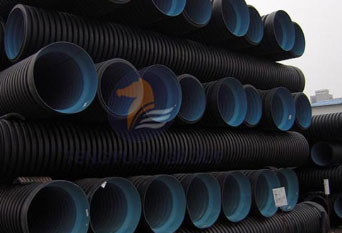HDPE Corrugated Pipe construction technology in municipal rainwater pipes:
(1) Trench excavation. Before excavating the trenches of the pipeline, comprehensively understand the geological conditions of the construction site, the groundwater conditions, and the design requirements of the rainwater system, and reasonably determine the buried depth and basic treatment methods of the pipeline. Among them, the most important task is to verify the bearing capacity of the foundation foundation. If it does not meet the construction requirements, it should be treated by means of replacement and riprap to improve the bearing capacity of the foundation. After preparing for the construction, the trenches are mined according to the pipeline construction plan, and the geometrical dimensions of the grooves must conform to the design scheme. If there are loose stones and clods at the bottom of the groove, remove it and lay a sand layer on it, tamping and leveling to prevent the hard object from damaging the HDPE Corrugated Pipe.
(2) Installation. Install the HDPE double-wall corrugated pipe and review the parameters such as the depth, width and bottom hole elevation of the groove. After confirming that there are no gravel or broken soil in the groove, the installation work is officially started. The HDPE double-wall corrugated pipe itself is of low quality and generally does not require a large hoisting device. If the pipeline is buried below 3.0m and the diameter is lower than DN500, the lower tube can be manually used. If the pipeline is buried deeper than 3.0m and the diameter is higher than DN500, it needs to be installed by hoisting. When hoisting and installing, the pipe should be laid down to the bottom of the groove to be stable, and the foundation cannot be disturbed. When it is necessary to cut the pipe, the pipe cut surface should be vertical and flat, and the pipe itself cannot be damaged. When installing, pay attention to the following points: First, the pipeline should be laid straight, if the line is to be laid, the relative rotation angle should not be greater than 2. Secondly, after the pipeline is lowered, the drainage in the trench should be good, there should be no water accumulation to prevent electric shock accidents; third, the interface between the pipe and the pipe should have a certain vacancy to facilitate subsequent connection.
(3) Connection. HDPE Corrugated Pipe connection methods mainly include heat shrink sleeve connection, electric hot melt ribbon connection, etc., and the operation points are different. In the heat shrinkable sleeve connection mode, first clean the surface moisture and debris of the pipe, and tightly entangle the pipe joint with the heat shrink tape, and slightly heat the contact zone between the heat shrink tape and the pipe with a flame gun. After that, the other heat shrinkable tape is used to wrap the baked heat shrinkable tape, and the clip is clamped, and then baked with a flame gun in the heat shrinkable tape wrapping portion, first up and down, left and right, so that the heat shrinkable tape and the pipe are completely tight. paste. In the electric hot melt belt connection mode, the surface of the pipe should also be cleaned first, and the joint part should be wrapped with electric heating tape, and fastened with a buckle. Connect the electric hot melt belt to the electric hot melt machine to set the current intensity and heating time. After the electric fuse is completed, fasten the buckle and cool it for a while. After checking that the connection quality meets the standard requirements, loosen the buckle. In addition to the connection between the pipe and the pipe, the connection of the HDPE Corrugated Pipe to the well should also be emphasized. The H DPE double-wall corrugated pipe first penetrates into the well from the pipe trench and supports the pipe with support to prevent concentrated load or shear. Commonly used method for connecting H DPE double-wall corrugated pipe and well wall: Apply PVC adhesive on the joint of HDPE double-wall corrugated pipe and well wall, lay a layer of fine sand on it, and deep the pipe wall In the middle, the cement mortar is used to build the blockage.
(4) Closed water test. After the pipeline is connected, conduct a water shut-off test to confirm whether the tightness of the pipeline in the water injection condition meets the requirements. First, check the inside of the pipe for blockages, water accumulation, etc. After confirming that there is no such situation, inject water into the pipe. After the water is injected, keep it for a while. If the pipeline project is large in scale and it is impossible to implement the closed water experiment one by one, the closed water test pipeline can be determined by sampling. If water seepage or water leakage is found, stop the test immediately, re-connect the pipe, and conduct the closed water test again.
(5) Backfilling. After completing the above work, proceed to backfill the work. First backfill from the joint between the pipeline and the foundation. The method is symmetrical. It is forbidden to backfill the other side after backfilling. The tamping also uses a symmetrical approach to reduce the impact on the pipeline and avoid deformation of the pipeline. When backfilling, the layered filling method is adopted, and the thickness of each backfill is controlled between 0.15m and 0.20m. The thickness of the backfill layer at the top of the pipe is about 0.70m. If conditions permit, mechanical rolling can be used to ensure that the backfill compaction meets the design requirements.
We have our own HDPE Corrugated Pipe Factory, warmly welcome new and old customers to visit and patronize!
